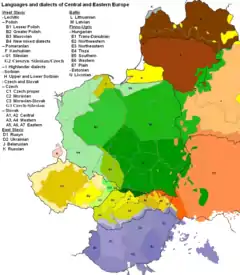Silesian language
Silesian or Upper Silesian (Silesian: ślōnskŏ gŏdka / ślůnsko godka [ˈɕlonskɔ ˈɡɔtka]; Czech: slezština; Polish: gwara śląska, język śląski, etnolekt śląski; German: Schlonsakisch, Wasserpolnisch (pej.)) from the West Slavic language family. Some linguists say, that it is a dialect of Polish, because of big similarities between these languages. It's mostly spoken in Poland, but also in the Czech Republic and Germany.
| Silesian | |
|---|---|
| Upper Silesian | |
| ślōnskŏ gŏdka ślůnsko godka | |
| Pronunciation | [ˈɕlonskɔ ˈɡɔtka] |
| Native to | Poland (Silesian Voivodeship, Opole Voivodeship), Czech Republic (Moravia–Silesia, Jeseník) |
| Region | Upper Silesia / Silesia |
| Ethnicity | Silesians |
Native speakers | 510,000 (2011 census)[1] |
Early form | Old Polish
|
| Latin script (Silesian alphabet)[3] | |
| Language codes | |
| ISO 639-3 | szl |
| Glottolog | sile1253 |
| ELP | Upper Silesian |
| Linguasphere | 53-AAA-cck, 53-AAA-dam |

Range of Silesian on a map of East-Central Europe (marked as G1 and G2, in southern Poland and the eastern Czech Republic).
References
Wikimedia Commons has media related to Silesian language.
- "Raport z wyników: Narodowy Spis Powszechny Ludności i Mieszkań 2011" [Report of results: National Census of Population and Housing, 2011.] (PDF). Central Statistical Office of Poland (in Polish). 2011. Archived from the original (PDF) on 2012-10-21.
- "Ethnologue report for language code: szl". Ethnologue. Languages of the World.
- Silesian language at Ethnologue (21st ed., 2018)
Silesian edition of Wikipedia, the free encyclopedia
This article is issued from Wikipedia. The text is licensed under Creative Commons - Attribution - Sharealike. Additional terms may apply for the media files.